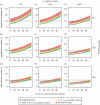Mapping social distancing measures to the reproduction number for COVID-19
- PMID: 34053268
- PMCID: PMC8165600
- DOI: 10.1098/rstb.2020.0276
Mapping social distancing measures to the reproduction number for COVID-19
Abstract
In the absence of a vaccine, severe acute respiratory syndrome-coronavirus 2 (SARS-CoV-2) transmission has been controlled by preventing person-to-person interactions via social distancing measures. In order to re-open parts of society, policy-makers need to consider how combinations of measures will affect transmission and understand the trade-offs between them. We use age-specific social contact data, together with epidemiological data, to quantify the components of the COVID-19 reproduction number. We estimate the impact of social distancing policies on the reproduction number by turning contacts on and off based on context and age. We focus on the impact of re-opening schools against a background of wider social distancing measures. We demonstrate that pre-collected social contact data can be used to provide a time-varying estimate of the reproduction number (R). We find that following lockdown (when R= 0.7, 95% CI 0.6, 0.8), opening primary schools has a modest impact on transmission (R = 0.89, 95% CI 0.82-0.97) as long as other social interactions are not increased. Opening secondary and primary schools is predicted to have a larger impact (R = 1.22, 95% CI 1.02-1.53). Contact tracing and COVID security can be used to mitigate the impact of increased social mixing to some extent; however, social distancing measures are still required to control transmission. Our approach has been widely used by policy-makers to project the impact of social distancing measures and assess the trade-offs between them. Effective social distancing, contact tracing and COVID security are required if all age groups are to return to school while controlling transmission. This article is part of the theme issue 'Modelling that shaped the early COVID-19 pandemic response in the UK'.
Keywords: COVID-19 reproduction number; school closures; social contact data; social distancing measures.
Figures




References
-
- Read JM, Bridgen JR, Cummings DA, Ho A, Jewell CP. 2020. Novel coronavirus 2019-nCoV: early estimation of epidemiological parameters and epidemic predictions. medRxiv. 2020.01.23.20018549. (10.1101/2020.01.23.20018549) - DOI
-
- Challen RJ, et al. . 2020. Estimates of regional infectivity of COVID-19 in the United Kingdom following imposition of social distancing measures. medRxiv 2020.04.13.20062760. (10.1101/2020.04.13.20062760) - DOI
Publication types
MeSH terms
Grants and funding
LinkOut - more resources
Full Text Sources
Other Literature Sources
Medical
Miscellaneous

